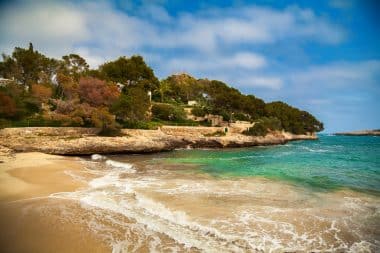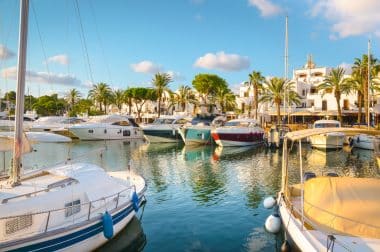Cala d’Or is located on the hilly slopes of a pine forest above the turquoise to deep blue sea. It is 60 kilometres from here to Palma. The resort in the southeast of Mallorca differs from other holiday resorts on the island: it is older and more beautiful. In summer it gets very crowded, but Cala d’Or (“Golden Bay”) was never suitable for excessive mass tourism. There are no high-rise hotel buildings. White, low buildings with a few floors under large pine trees dominate the picture in the old town centre. A flair of exclusivity lies over the marina on the narrow Cala Llonga in the west of the village.
A holiday resort with Ibiza-style houses

Cala d’Or owes its careful development to the artist and architect Josep Costa Ferrer from Ibiza. In the 1930s, he bought the piece of coast on which Cala d’Or is located today. He wanted to turn it into a holiday resort with Ibiza-style villas. He succeeded in doing so with the help of other founders. In the beginning, Cala d’Or was the preferred place for artists – for painters and architects. But Cala d’Or has grown over the years and with increasing tourism, on the edges and in the hinterland the buildings are no longer in style. Cala d’Or has almost 4200 inhabitants.
Market with flair in the nearby town of Santanyi
Cala d’Or belongs to the municipality of Santanyi – the nearby town that is also worth a visit. Every Wednesday and Saturday morning there is a market with a special flair! Mallorcans, residents and German holidaymakers meet here. From fruit and vegetables to underwear, handicrafts, souvenirs and homemade organic cheese, everything is offered at the stalls at the foot of the parish church. Cala d’Or’s neighbouring towns on the coast are also worth seeing. Porto Colom is located in the northeast, Porto Petro in the southwest – both are picturesque harbour towns with very good restaurants.
The inviting town centre is located on the bay of Cala Gran
If you come to Cala d’Or from the north, you will have passed the street villages of S’Alqueria Blanca, Calonge or S’Horta on the Ma-4012. From here it is only a few kilometers to the destination. They lead through fields and almond plantations to the right and left of the road. As early as January, the almond blossom begins early here and then envelops the country in a delicate, white-pink veil. At the entrance to the village there is a large roundabout, in the middle of which stands a modern metal sculpture. If you continue straight ahead on the tree-lined Avenida, you will reach the town centre and the main bay of the village, Cala Gran. This is the largest bay. A little above and behind it are hotels, holiday homes, apartments and countless shops.
Parents with children love the small Cala d’Or cove
Cross-country beach skiers will not get their money’s worth in Cala d’Or, as the coves with beautiful yellow-white, fine sand are all bordered by rocks. In Cala d’Or, visitors can climb on the rocks into the nearest bay, the eponymous Cala d’Or. But for that you have to be sure-footed and fit – and have the appropriate footwear. The Cala d’Or bay seems small and intimate, the water is usually calm, because it is protected by a headland in front of it. That’s why families with children like to use it for swimming, digging and snorkeling. Other coves are the already mentioned Cala Llonga, Cala Ferrera, Cala Esmeralda and Cala Serena. If you don’t want to visit it on foot, you can explore it with the small tourist train, which also goes to Porto Petro.
Stroll and dine in the marina

In the high season, it gets crowded in the pedestrian zone in the evening. Cala d’Or has a restaurant mile on Av. Bélgica not far from Puntetes Square. The restaurants are geared towards international guests. Holidaymakers can compare German, Italian, Mexican, Spanish and Mallorcan cuisines here. But it is more romantic in the evening in the marina on both sides of Cala Llonga. On the bar terraces, guests sit close to the sea and enjoy the view of the sailboats bobbing on the water. On the west side of Cala Llonga, at the tip of the headland, lies the fortification Es Forti – a castle-like quadradic structure that once served as a defence against pirates. From May to October you can take a boat from Cala D’Or to Porto Colom and also to Cala Figuera . The latter village, an old fishing village, is impressive. It is located on a very long fjord with a small, natural harbour and colourful boathouses. It is fun to eat fish in a restaurant above the rocky bay, which may have been caught off Cala Figuera.
Nature reserve with many hiking trails
A special excursion takes holidaymakers to the Parc Natural Mondragó nature reserve, southwest of Cala d’Or with large parking lots. There is also an excursion bus from Cala d’Or to get there. The beautiful large rocky bays with turquoise shimmering water and sandy beaches of this park are completely undeveloped. They invite you to swim in crystal clear water. Well-paved, well-maintained and wooded hiking trails lead over the cliffs to viewpoints from which you can enjoy the view of the coastline. Here you can walk from one bay to the other, the most beautiful is probably S’Amarador on the edge of the pine forest. Cala Mondragó, on the other hand, is suitable for resting, as there is a beach kiosk here that offers drinks and small meals.


